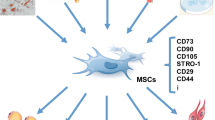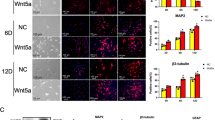Abstract
Mesenchymal stem cells have been intensively studied for their potential use in reparative strategies for neurodegenerative diseases and traumatic injuries. We used mesenchymal stem cells (rMSC) from rat bone marrow to evaluate the therapeutic potential after spinal cord injury (SCI). Immunohistochemistry confirmed a large number of apoptotic neurons and oligodendrocytes in caudal segments 2 mm away from the lesion site. Expression of caspase-3 on both neurons and oligodendrocytes after SCI was significantly downregulated by rMSC. Caspase-3 downregulation by rMSC involves increased expression of FLIP and XIAP in the cytosol and inhibition of PARP cleavage in the nucleus. Animals treated with rMSC had higher Basso, Beattie, Bresnahan (BBB) locomotor scoring and better recovery of hind limb sensitivity. Treatment with rMSC had a positive effect on behavioral outcome and histopathological assessment after SCI. The ability of rMSC to incorporate into the spinal cord, differentiate and to improve locomotor recovery hold promise for a potential cure after SCI.









Similar content being viewed by others
Abbreviations
- APC:
-
Adenomatous polyposis coli
- BBB:
-
Basso Beattie Bresnahan locomotor scoring
- BCA:
-
Bicinchoninic acid
- BDNF:
-
Brain derived neurotrophic factor
- bFGF:
-
Basic fibroblast growth factor
- BSA:
-
Bovine serum albumin
- CHAPS:
-
3-[(3-Cholamidopropyl) dimethylammonio]-1-propanesulfonate
- CNPase:
-
2′,3′-cyclicnucleotide-3′-phosphodiesterase
- DAB:
-
Diaminobenzidine
- DAPI :
-
4′,6-Diamidino-2-phenylindole dihydrochloride
- DPI:
-
Days post injury
- DTT:
-
Dithiothreitol
- FBS:
-
Fetal bovine serum
- FITC:
-
Fluorescein isothiocyanate
- FLIP:
-
FLICE-inhibitory protein
- GFAP:
-
Glial fibrillary acidic protein
- hEGF:
-
Human epidermal growth factor
- HRP:
-
Horseradish peroxidase
- β-NGF:
-
Beta-nerve growth factor
- NF-200:
-
Neurofilament H-200 kD
- NT-3:
-
Neurotrophic hormone-3
- PARP:
-
Poly[ADP-ribose] polymerase
- PBS:
-
Phosphate buffered saline
- PMSF:
-
Phenyl methane sulfonyl fluoride
- RA:
-
Retinoic acid
- rMSC:
-
Rat bone marrow mesenchymal stem cells
- SCI:
-
Spinal cord injury
- XIAP:
-
X-linked inhibitor of apoptosis protein
References
Akiyama Y, Radtke C, Kocsis JD (2002) Remyelination of the rat spinal cord by transplantation of identified bone marrow stromal cells. J Neurosci 22:6623–6630
McDonald JW, Liu XZ, Qu Y, Liu S, Mickey SK, Turetsky D, Gottlieb DI, Choi DW (1999) Transplanted embryonic stem cells survive, differentiate and promote recovery in injured rat spinal cord. Nat Med 5:1410–1412
Kopen GC, Prockop DJ, Phinney DG (1999) Marrow stromal cells migrate throughout forebrain and cerebellum, and they differentiate into astrocytes after injection into neonatal mouse brains. Proc Natl Acad Sci USA 96:10711–10716
Woodbury D, Schwarz EJ, Prockop DJ, Black IB (2000) Adult rat and human bone marrow stromal cells differentiate into neurons. J Neurosci Res 61:364–370
Crowe MJ, Bresnahan JC, Shuman SL, Masters JN, Beattie MS (1997) Apoptosis and delayed degeneration after spinal cord injury in rats and monkeys. Nat Med 3:73–76
Emery E, Aldana P, Bunge MB, Puckett W, Srinivasan A, Keane RW, Bethea J, Levi AD (1998) Apoptosis after traumatic human spinal cord injury. J Neurosurg 89:911–920
Li GL, Farooque M, Holtz A, Olsson Y (1999) Apoptosis of oligodendrocytes occurs for long distances away from the primary injury after compression trauma to rat spinal cord. Acta Neuropathol (Berl) 98:473–480
Liu XZ, Xu XM, Hu R, Du C, Zhang SX, McDonald JW, Dong HX, Wu YJ, Fan GS, Jacquin MF, Hsu CY, Choi DW (1997) Neuronal and glial apoptosis after traumatic spinal cord injury. J Neurosci 17:5395–5406
Shuman SL, Bresnahan JC, Beattie MS (1997) Apoptosis of microglia and oligodendrocytes after spinal cord contusion in rats. J Neurosci Res 50:798–808
Abe Y, Yamamoto T, Sugiyama Y, Watanabe T, Saito N, Kayama H, Kumagai T (1999) Apoptotic cells associated with Wallerian degeneration after experimental spinal cord injury: a possible mechanism of oligodendroglial death. J Neurotrauma 16:945–952
Warden P, Bamber NI, Li H, Esposito A, Ahmad KA, Hsu CY, Xu XM (2001) Delayed glial cell death following wallerian degeneration in white matter tracts after spinal cord dorsal column cordotomy in adult rats. Exp Neurol 168:213–224
Casha S, Yu WR, Fehlings MG (2005) FAS deficiency reduces apoptosis, spares axons and improves function after spinal cord injury. Exp Neurol 196:390–400
Citron BA, Arnold PM, Sebastian C, Qin F, Malladi S, Ameenuddin S, Landis ME, Festoff BW (2000) Rapid upregulation of caspase-3 in rat spinal cord after injury: mRNA, protein, and cellular localization correlates with apoptotic cell death. Exp Neurol 166:213–226
Katoh K, Ikata T, Katoh S, Hamada Y, Nakauchi K, Sano T, Niwa M (1996) Induction and its spread of apoptosis in rat spinal cord after mechanical trauma. Neurosci Lett 216:9–12
Lee SM, Yune TY, Kim SJ, Park DW, Lee YK, Kim YC, Oh YJ, Markelonis GJ, Oh TH (2003) Minocycline reduces cell death and improves functional recovery after traumatic spinal cord injury in the rat. J Neurotrauma 20:1017–1027
Lou J, Lenke LG, Ludwig FJ, O’Brien MF (1998) Apoptosis as a mechanism of neuronal cell death following acute experimental spinal cord injury. Spinal Cord 36:683–690
Nottingham S, Knapp P, Springer J (2002) FK506 treatment inhibits caspase-3 activation and promotes oligodendroglial survival following traumatic spinal cord injury. Exp Neurol 177:242–251
Nottingham SA, Springer JE (2003) Temporal and spatial distribution of activated caspase-3 after subdural kainic acid infusions in rat spinal cord. J Comp Neurol 464:463–471
Springer JE, Azbill RD, Knapp PE (1999) Activation of the caspase-3 apoptotic cascade in traumatic spinal cord injury. Nat Med 5:943–946
Springer JE, Azbill RD, Nottingham SA, Kennedy SE (2000) Calcineurin-mediated BAD dephosphorylation activates the caspase-3 apoptotic cascade in traumatic spinal cord injury. J Neurosci 20:7246–7251
Yong C, Arnold PM, Zoubine MN, Citron BA, Watanabe I, Berman NE, Festoff BW (1998) Apoptosis in cellular compartments of rat spinal cord after severe contusion injury. J Neurotrauma 15:459–472
Casha S, Yu WR, Fehlings MG (2001) Oligodendroglial apoptosis occurs along degenerating axons and is associated with FAS and p75 expression following spinal cord injury in the rat. Neuroscience 103:203–218
Basso DM, Beattie MS, Bresnahan JC (1995) A sensitive and reliable locomotor rating scale for open field testing in rats. J Neurotrauma 12:1–21
Merkler D, Metz GA, Raineteau O, Dietz V, Schwab ME, Fouad K (2001) Locomotor recovery in spinal cord-injured rats treated with an antibody neutralizing the myelin-associated neurite growth inhibitor Nogo-A. J Neurosci 21:3665–3673
Laemmli UK, Favre M (1973) Maturation of the head of bacteriophage T4. I. DNA packaging events. J Mol Biol 80:575–899
Li GL, Brodin G, Farooque M, Funa K, Holtz A, Wang WL, Olsson Y (1996) Apoptosis and expression of Bcl-2 after compression trauma to rat spinal cord. J Neuropathol Exp Neurol 55:280–289
Ohori Y, Yamamoto S, Nagao M, Sugimori M, Yamamoto N, Nakamura K, Nakafuku M (2006) Growth factor treatment and genetic manipulation stimulate neurogenesis and oligodendrogenesis by endogenous neural progenitors in the injured adult spinal cord. J Neurosci 26:11948–11960
Klein S, Svendsen CN (2005) Stem cells in the injured spinal cord: reducing the pain and increasing the gain. Nat Neurosci 8:259–260
Ankeny DP, McTigue DM, Jakeman LB (2004) Bone marrow transplants provide tissue protection and directional guidance for axons after contusive spinal cord injury in rats. Exp Neurol 190:17–31
Goh EL, Ma D, Ming GL, Song H (2003) Adult neural stem cells and repair of the adult central nervous system. J Hematother Stem Cell Res 12:671–679
McDonald JW, Howard MJ (2002) Repairing the damaged spinal cord: a summary of our early success with embryonic stem cell transplantation and remyelination. Prog Brain Res 137:299–309
Ruitenberg MJ, Vukovic J, Sarich J, Busfield SJ, Plant GW (2006) Olfactory ensheathing cells: characteristics, genetic engineering, and therapeutic potential. J Neurotrauma 23:468–478
Cizkova D, Rosocha J, Vanicky I, Jergova S, Cizek M (2006) Transplants of human mesenchymal stem cells improve functional recovery after spinal cord injury in the rat. Cell Mol Neurobiol 26:1167–1180
Kuh SU, Cho YE, Yoon DH, Kim KN, Ha Y (2005) Functional recovery after human umbilical cord blood cells transplantation with brain-derived neutrophic factor into the spinal cord injured rat. Acta Neurochir (Wien) 147:985–992
Liu S, Qu Y, Stewart TJ, Howard MJ, Chakrabortty S, Holekamp TF, McDonald JW (2000) Embryonic stem cells differentiate into oligodendrocytes and myelinate in culture and after spinal cord transplantation. Proc Natl Acad Sci USA 97:6126–6131
Lu P, Jones LL, Tuszynski MH (2005) BDNF-expressing marrow stromal cells support extensive axonal growth at sites of spinal cord injury. Exp Neurol 191:344–360
Lu P, Jones LL, Snyder EY, Tuszynski MH (2003) Neural stem cells constitutively secrete neurotrophic factors and promote extensive host axonal growth after spinal cord injury. Exp Neurol 181:115–129
Saporta S, Kim JJ, Willing AE, Fu ES, Davis CD, Sanberg PR (2003) Human umbilical cord blood stem cells infusion in spinal cord injury: engraftment and beneficial influence on behavior. J Hematother Stem Cell Res 12:271–278
Movsesyan VA, Yakovlev AG, Fan L, Faden AI (2001) Effect of serine protease inhibitors on posttraumatic brain injury and neuronal apoptosis. Exp Neurol 167:366–375
Ozawa H, Keane RW, Marcillo AE, Diaz PH, Dietrich WD (2002) Therapeutic strategies targeting caspase inhibition following spinal cord injury in rats. Exp Neurol 177:306–313
Genovese T, Mazzon E, Di Paola R, Muia C, Threadgill MD, Caputi AP, Thiemermann C, Cuzzocrea S (2005) Inhibitors of poly(ADP-ribose) polymerase modulate signal transduction pathways and the development of bleomycin-induced lung injury. J Pharmacol Exp Ther 313:529–538
Keane RW, Kraydieh S, Lotocki G, Bethea JR, Krajewski S, Reed JC, Dietrich WD (2001) Apoptotic and anti-apoptotic mechanisms following spinal cord injury. J Neuropathol Exp Neurol 60:422–429
Scott GS, Szabo C, Hooper DC (2004) Poly(ADP-ribose) polymerase activity contributes to peroxynitrite-induced spinal cord neuronal cell death in vitro. J Neurotrauma 21:1255–1263
Acknowledgments
We thank Noorjehan Ali for technical assistance. We thank Shellee Abraham for manuscript preparation and Diana Meister and Sushma Jasti for manuscript review. This research was supported by National Cancer Institute Grant CA 75557, CA 92393, CA 95058, CA 116708, N.I.N.D.S. NS47699 and NS57529, and Caterpillar, Inc., OSF Saint Francis, Inc., Peoria, IL (to J.S.R.).
Author information
Authors and Affiliations
Corresponding author
Additional information
Special issue in honor of Naren Banik.
Rights and permissions
About this article
Cite this article
Dasari, V.R., Spomar, D.G., Cady, C. et al. Mesenchymal Stem Cells from Rat Bone Marrow Downregulate Caspase-3-mediated Apoptotic Pathway After Spinal Cord Injury in Rats. Neurochem Res 32, 2080–2093 (2007). https://doi.org/10.1007/s11064-007-9368-z
Received:
Accepted:
Published:
Issue Date:
DOI: https://doi.org/10.1007/s11064-007-9368-z




